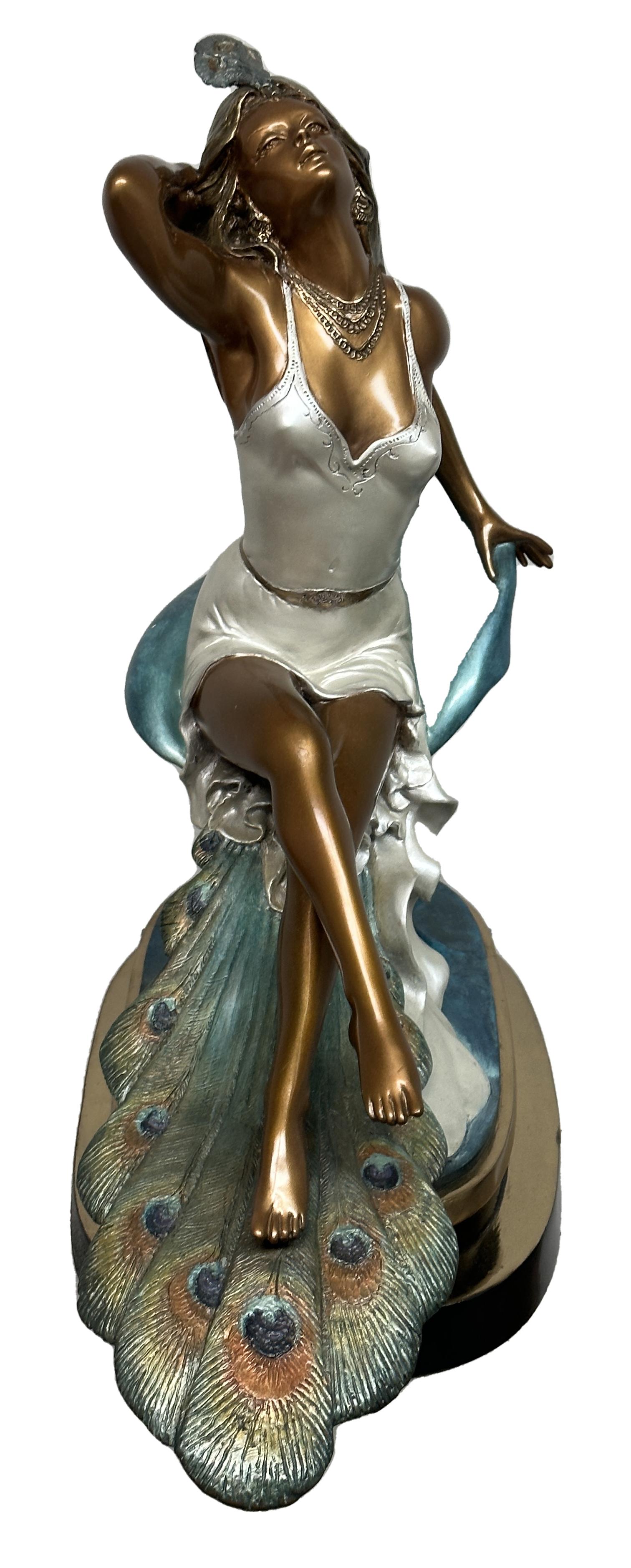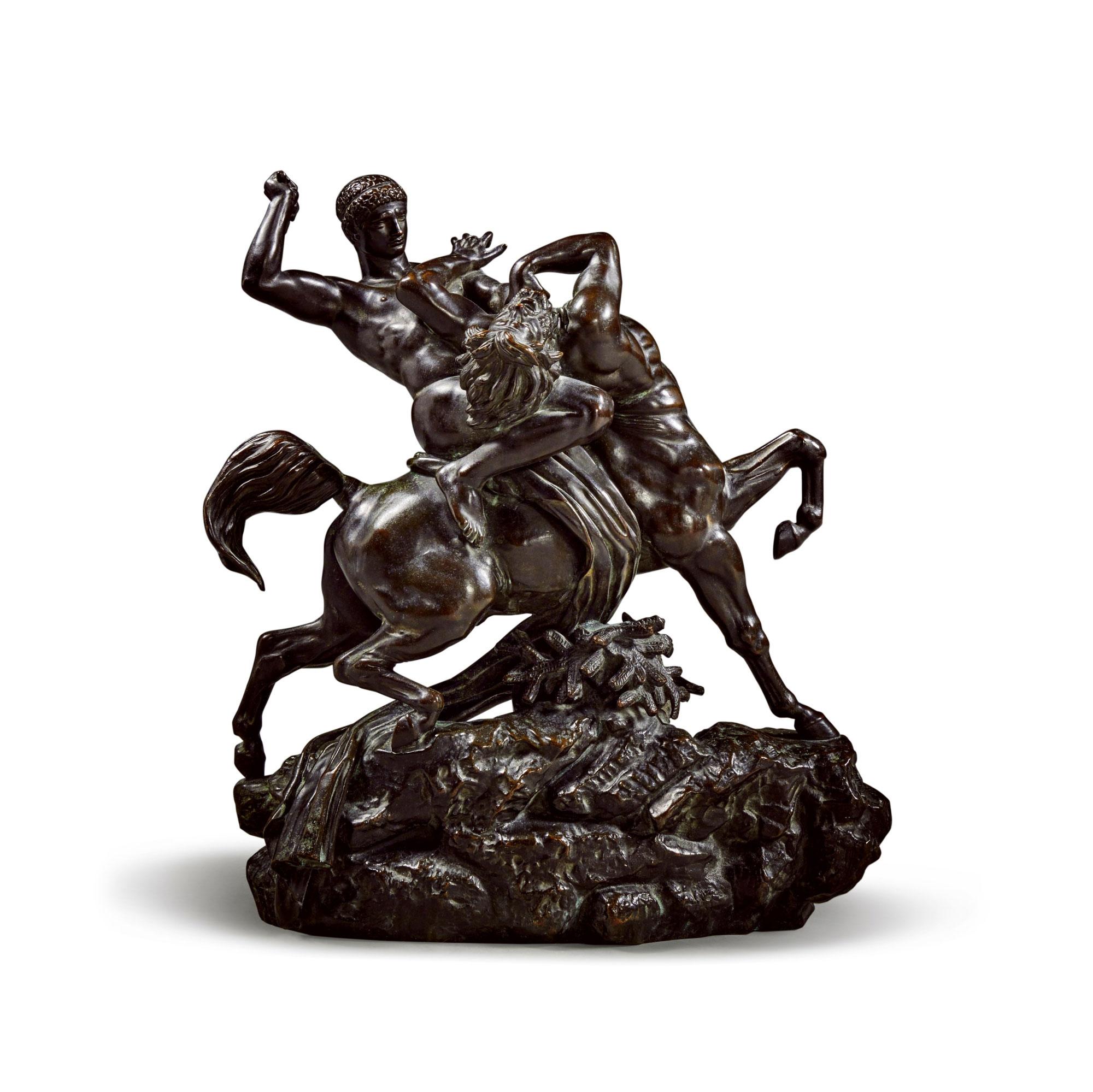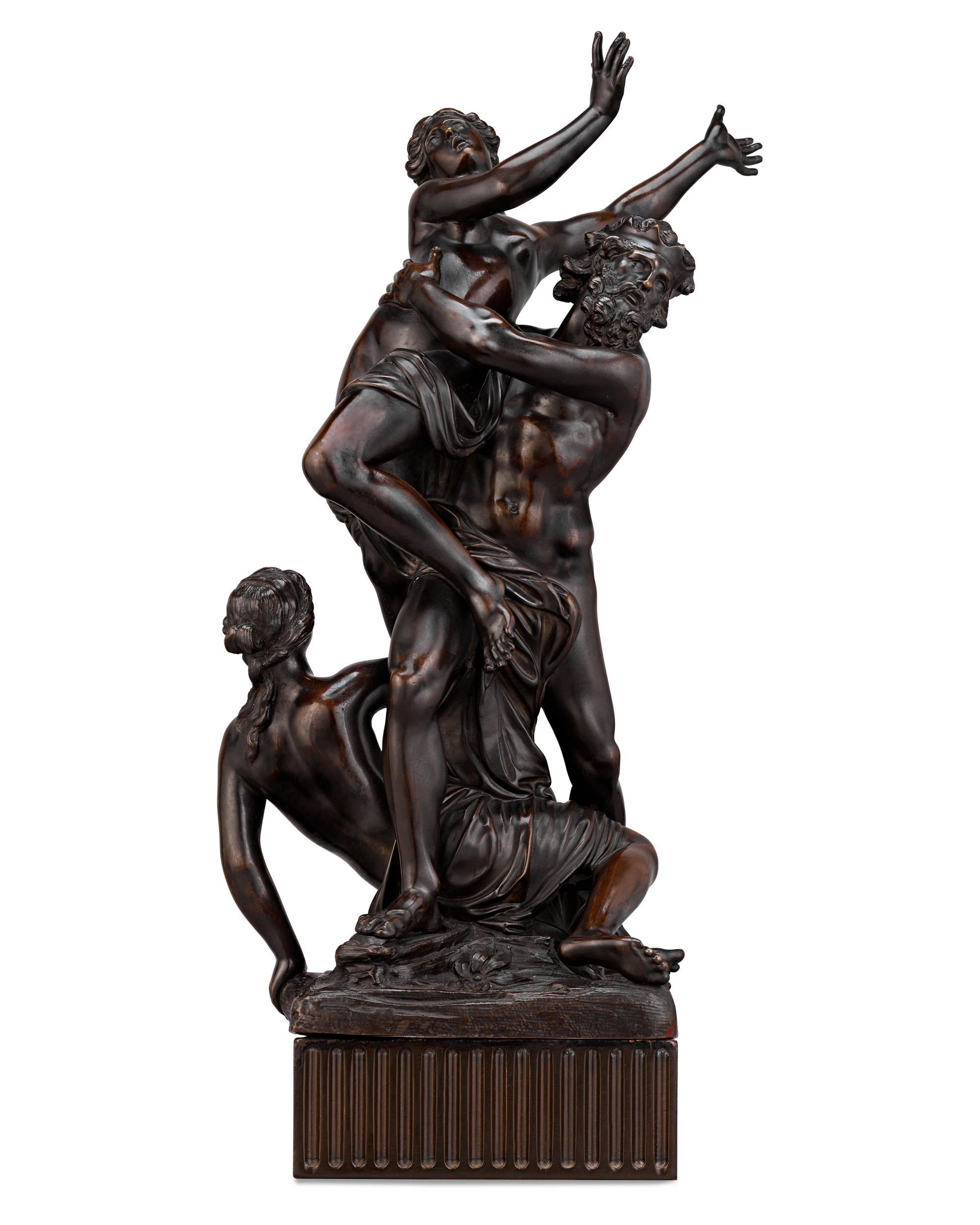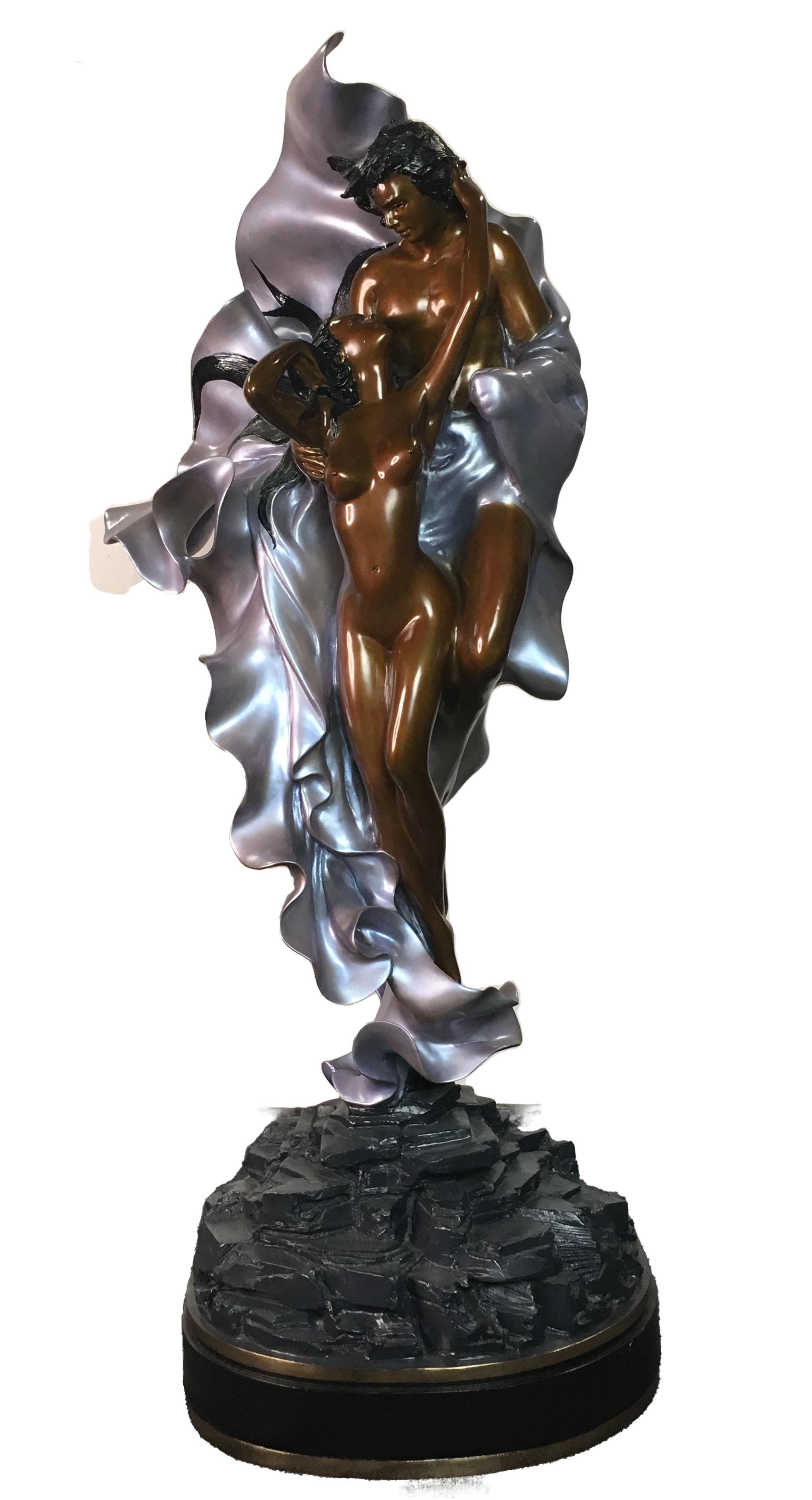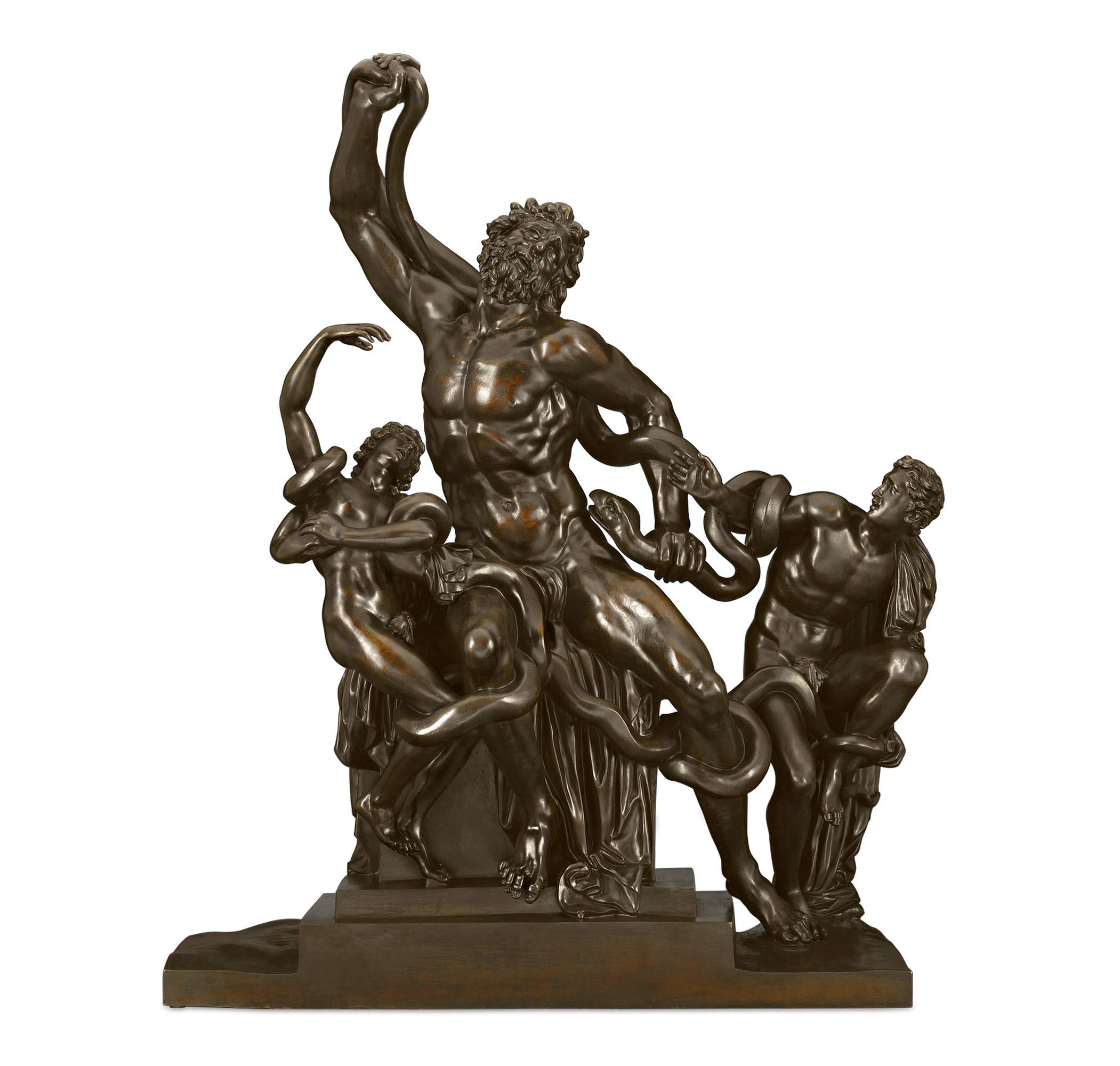Items Similar to Laocoön And His Sons By Adriaen De Vries
Want more images or videos?
Request additional images or videos from the seller
1 of 7
Adriaen de VriesLaocoön And His Sons By Adriaen De VriesCirca 1590
Circa 1590
About the Item
Adriaen de Vries
1556-1626 Dutch
Laocoön and His Sons
Bronze
A remarkable feat of artistry and skill, this bronze sculpture was created by famed Dutch artist Adriaen de Vries. Full of the swelling emotions and dramatic posing so quintessential to the period, the bronze is a masterclass in Baroque sculpture.
The original Laocoön marble sculpture, after which this remarkable bronze was modeled, unquestionably influenced the lives and works of countless artists, authors, popes, kings and emperors since its re-discovery in 1506. Famously, Michelangelo declared the sculpture, created circa 35 BC, as the “greatest piece of art in the world.” Adriaen de Vries, an apprentice of the great sculptor Giambologna, undoubtedly sought to prove his skill and creative voice with his own depiction of this most famous scene. Known for his virtuosic casting technique, this rare and important sculpture embodies de Vries’ mastery.
The story of Laocoön is one of the most famous in all of literature. As told by the poet Virgil, the Greeks, after an unsuccessful ten-year siege on the city of Troy, the Greeks craftily left a giant wooden horse outside the gates of the city with a small contingency hidden inside. A cunning Greek soldier named Sinon was left to offer an explanation of this unusual gift. Laocoön, the Trojan high priest who questioned Sinon, was not persuaded and proclaimed the warning, “Beware of Greeks bearing gifts!” The Goddess Minerva, eager to protect her Greeks, immediately sent two sea serpents to kill Laocoön and his twin sons before they could warn more Trojans of this deception. Beautifully crafted, this present bronze displays all of the dynamic artistry and poignant expression for which the original is so celebrated.
Coveted by the world’s most important museums, sculptures by de Vries can be found in the Metropolitan Museum of Art in New York, the Louvre in Paris, the National Gallery of Art in Washington D.C. and many royal collections across Europe. Needless to state, examples only rarely come to market. The only other known Laocoön sculpture by de Vries is part of the permanent collection of the Fitzwilliam Museum at Cambridge University. Laocoön is considered by many experts to be the greatest sculpture depicting movement ever crafted, making this rare 16th-century example an awe-inspiring treasure.
Circa 1590
On base: 5 3/8" high by 5" wide by 2 5/8" deep
- Creator:Adriaen de Vries (1556 - 1626, Dutch)
- Creation Year:Circa 1590
- Dimensions:Height: 5.38 in (13.67 cm)Width: 5 in (12.7 cm)Depth: 2.63 in (6.69 cm)
- Medium:
- Movement & Style:
- Period:
- Condition:
- Gallery Location:New Orleans, LA
- Reference Number:
About the Seller
5.0
Vetted Seller
These experienced sellers undergo a comprehensive evaluation by our team of in-house experts.
Established in 1912
1stDibs seller since 2013
15 sales on 1stDibs
Typical response time: 4 hours
- ShippingRetrieving quote...Ships From: New Orleans, LA
- Return PolicyThis item cannot be returned.
More From This SellerView All
- Bronze of Pluto Abducting Proserpine after François GirardonLocated in New Orleans, LAAfter François Girardon 1628-1715 French Pluto Abducting Proserpine Bronze This High Baroque period composition captures the famed narrative of Pluto and Proserpine from Roman mythology. The late 17th-century patinated bronze, created after François Girardon's marble composition, captures the very moment that Pluto seizes Proserpine. The anguished goddess reaches skyward, attempting to escape the god’s grasp while Pluto’s stoic face betrays his knowledge that his ploy will succeed. This pivotal moment in the mythological tale has captured the imagination of many art historical greats, from Bernini to Rubens. François Girardon’s version of the climax demonstrates incredible finesse and artistry, modeled expertly in bronze in the present work by a later sculptor. The statue brings a twist of intertwined bodies into a dynamic frenzy, paralleling the tension of the legendary story. In ancient Roman mythology, Proserpine, the beautiful daughter of Ceres — known as Persephone in Greek mythology — was picking flowers in the fields when she was suddenly abducted by Pluto, the god of the underworld, and taken to his kingdom. Consumed with grief, her mother Ceres, the goddess of agriculture, scorches the earth, stopping the growth of grain and fruit. Jupiter attempts to intervene and secure Proserpine’s return to earth, negotiating a compromise with Pluto and the Fates that allows Proserpine to be released for part of the year before returning to Pluto’s underworld. Proserpine’s journey back and forth is an allegory for the changing seasons; when Prosperine is with her mother, the earth warms and provides bountiful harvests. Upon her annual return to the underworld, however, the earth once again becomes cold and barren. After returning to France after years of training in Rome, François Girardon quickly rose to become one of the greatest artists in France. He was elected a member of the Académie Royale de Peinture et de Sculpture in 1657 and would become Chancellor of the Royal Academy in 1695. The artist was approached frequently for royal commissions and Girardon’s Pluto was originally commissioned by Louis XIV for the gardens at his Palace of Versailles. It was one of four monumental marble groups intended to decorate the corners of Charles Le Brun’s never completed garden at the chateau, the Parterre d’Eau. Each group of three figures symbolized one of the four elements: earth, air, fire and water. Pluto’s association with hell made him the apt...Category
Early 18th Century Baroque Figurative Sculptures
MaterialsBronze
- Laocoön And His Sons BronzeLocated in New Orleans, LALaocoön and his Sons Italian Bronze Group after Agesander, Polydorus and Anthenodorus Late 18th Century “The greatest piece of art in the world.” - Michelangelo, Italian sculptor, p...Category
Late 18th Century Baroque Figurative Sculptures
MaterialsBronze
- Bust of Pope Innocent XI Odescalchi by Domenico GuidiLocated in New Orleans, LAThis monumental bust is a museum-quality example of Roman Baroque sculpture. Crafted by the legendary Domenico Guidi and carved from Carrara marble, the impressive portrait captures the visage of Pope Innocent XI, Benedetto Odescalchi (1611-1689). It presents a larger-than-life example of Guidi’s remarkable skill as a sculptor, which ultimately made his workshop one of the most important in Rome during his age. Today, his works are rarely found on the market, particularly his extraordinary works in marble. Pope Innocent XI was born Benedetto Odescalchi into an Italian noble family of prominent bankers. Spending his early years in banking, he eventually turned to the law, earning his doctorate in 1639. His background would serve him well in his service to the papacy, and he became known as a frugal and devout member of the Church. In 1676, he was unanimously elected Pop after the death of Clement X. During his nearly 13-year reign, he instilled his own personal ideals of austerity and frugality onto the Church, with a deep commitment to reform and piety. He is captured here by Guidi in his traditional Pope’s mozzetta and camauro cap. A wide stole is draped over his shoulders, ornamented by acanthus leaves and the coat of arms of the Odescalchi family. It displays Guidi’s mastery over the chiaroscuro effect, particularly in the high level of contrast in his cheeks and his eyes, which Guidi achieved through various methods of high polish. A very similar portrait sculpture of Pope Innocent XI by Guidi can be found in the collection of the Royal Castle in Warsaw. The Warsaw bust belongs to a series of portraits of popes which the Odescalchi family commissioned from Domenico Guidi in the 1690s. Compared to that example, the present bust is far more dramatic, with deeper cut lines and a more precise expression. It is likely that the present piece was seen by the Odescalchi family, who ordered a similar one to be made. The piece was almost certainly intended to be displayed in a niche, given its dramatic cutting and its roughly carved back. Others of Guidi’s busts can be found in important collections throughout Italy, England and the United States, though many of these are lesser bronze repetitions. A bronze bust of the Pope Alexander VIII by Guidi is currently in the collection of the Victoria & Albert Museum (London), while a terracotta version of the same is in the Los Angeles County Museum. A bronze of Pope Alexander VIII can be found in the Princely Collection of Lichtenstein, and his impressive marble papal bust of Clement IX graces the pope’s tomb in Santa Maria Maggiore. The present bust of Pope...Category
17th Century Baroque Figurative Sculptures
MaterialsMarble
- Girardon’s Equestrian Portrait of Louis XIVLocated in New Orleans, LAKing Louis XIV, one of France's greatest monarchs, sits confidently astride a prancing steed in this bronze equestrian statue. The extraordinary work is a reduction of the portrait of the Sun King by François Girardon, one of the most noted and influential sculptors of the period. Looking back to the great masterpieces of antiquity, Girardon took his inspiration from the seminal ancient Roman marble of Marcus Aurelius, now in the Musei Capitoline (Rome). Louis XIV is thus portrayed here as a conquering Roman hero, his costume adorned with many neoclassical motifs, hand outstretched in a gesture of command. The result is an imposing royal portrait of power and absolute authority that pays homage to one of the most important sovereigns in French history. It was in 1685, at the very height of his rule, when Louis XIV commissioned the monumental bronze of himself from the great Girardon. As sculptor to the king, Girardon was a key figure in the decoration of the gardens at the Château de Versailles, and he was later commissioned to complete several important royal...Category
19th Century Other Art Style Figurative Sculptures
MaterialsBronze
- Winston Churchill Artist Proof Bust by Ivor Roberts-JonesBy Ivor Roberts-JonesLocated in New Orleans, LAIvor Roberts-Jones 1916-1996 British Sir Winston Churchill Artist Proof Bronze with a green patina One of the greatest leaders of the modern world, Winston Churchill is among the...Category
20th Century Figurative Sculptures
MaterialsBronze
- Sir Winston Churchill Memorial By Ivor Roberts-JonesBy Ivor Roberts-JonesLocated in New Orleans, LAIvor Roberts-Jones 1916-1996 | British Sir Winston Churchill Memorial Bronze This exceptional and iconic sculpture of Sir Winston Churchill is the original maquette for the renown...Category
20th Century Academic Figurative Sculptures
MaterialsBronze
You May Also Like
- Gabriella Bronze SculptureLocated in Rochester Hills, MIAngelo Basso (Italy, 1943 – 2011) Gabriella Dimensions 17.0" W x 18.0" H x 7.0" D This sculpture was cast in the Dyansen Studios Foundry in 1991 under...Category
1980s Baroque Figurative Sculptures
MaterialsBronze
- Patinated Bronze Statue of Theseus and the Centaur by Antoine-Louis BaryeBy Antoine-Louis BaryeLocated in New York, NYTitle: Theseus and the Centaur Artist: Antoine-Louis Barye (1795-1875) Date: 19th Century Medium: Oil on panel Signature: Signed ‘AL BARYE’ and stamped with ...Category
19th Century Baroque Figurative Sculptures
MaterialsBronze
- Paolo And FrancescaLocated in Rochester Hills, MIAngelo Basso Bronze 1989 Paolo And Francesca- Size: Size: 42 x 12 x 12 in Signed and marked 92/95 "ITALIAN MASTER OF THE MODERN BAROQUE" The story o...Category
1980s Baroque Figurative Sculptures
MaterialsBronze
- Pair of 19th Century Busts by Albert Ernest Carrier-BelleuseBy Albert-Ernest Carrier-BelleuseLocated in Santa Fe, NMSigned: A. Carrier-Belluese Two large bronze matching busts of an unknown male and female 22 x 10 x 11" male 23 x 10 x 9" female Both show signs of wear with their age but are in fa...Category
19th Century Baroque Figurative Sculptures
MaterialsMarble, Bronze
- White tailed sea eagle and crabLocated in Oswestry, GBThis white tailed sea eagle is depicted here on a rock on the shore of a remote wild Scottish Isle (Outer Hebrides). Hiding beneath the rock is a brown crab...Category
16th Century Baroque Figurative Sculptures
MaterialsBronze
- 19th Century French Bacchanalian BronzeLocated in San Antonio, TX19th Century French Bacchanalian Bronze in the 18th century style depicting two Putti, in the manner of Clodion. One putto reclines while another feeds it grapes. The Patina is worn ...Category
Late 19th Century Baroque Figurative Sculptures
MaterialsBronze
Recently Viewed
View AllMore Ways To Browse
Antique De Provence
Greek Goddess Art
Small Greek Sculpture
Antique Emperor Sculpture
Antique Wooden Horse
Antique Wooden Horses
Soldier Modeling
Baroque Bronze Sculpture
16th Century Baroque
Siege Antique
Baroque Marble Sculpture
Sculpture Pope
Serpent Sculpture
Bronze Greek Goddess
Bronze Of Greek Goddess
Michelangelo Bronze
Antique Apprentice Piece
Goddess Marble Sculpture
